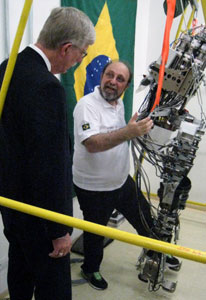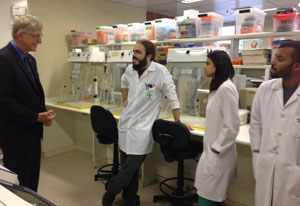Collins hails US-Brazil science collaborations
May / June 2014 | Volume 13, Issue 3
U.S.-Brazilian research partnerships were celebrated by NIH Director Dr. Francis S. Collins recently during a weeklong visit to Brazil. Collins toured top research sites and discussed the "exceptional opportunities" to expand scientific collaborations between the two countries, in fields such as HIV/AIDS, cancer, heart disease, neuroscience and bioengineering.

Photo by Dr. Roger Glass/Fogarty
During a recent weeklong visit to Brazil,
NIH Director Dr. Francis Collins watched
a demonstration of a mechanical
exoskeleton designed for paraplegics,
based on NIH neuroscience research.
Read the related blog post Neuroscience
Research Kicks Off World Cup by
Dr. Collins.
Brazil has a long history of research engagement with NIH and is the most successful country in Latin America in competing for its grants. But as Brazil has strengthened its scientific capacity, it is increasingly looking to NIH for technical assistance and research partnerships, rather than funding.
During his travels, Collins gave speeches to the Brazilian Biochemistry and Molecular Biology Society, University of São Paulo's School of Medicine, the State of São Paulo Research Foundation (FAPESP) and the NIH equivalent, Fundação Oswaldo Cruz (FIOCRUZ).
At the events, a number of Brazil's scientific leaders expressed interest in establishing parallel funding partnerships with NIH to help speed translation of findings into clinical practice, implement personalized medicine and better integrate electronic medical records and mobile technologies into the research enterprise. They also requested jointly funded research initiatives be established to study AIDS and HIV-associated malignancies, among other topics.
Collins used the occasion to announce a new collaboration between NIH and Brazil to identify therapeutic agents by studying the symbiotic bacteria carried by ants in Brazil. The bacteria can prevent growth of some fungi and might lead to new antifungal drugs. The potential is virtually unexplored, Collins noted, and will result in greater understanding of the chemical ecology of these complex interspecies relationships. Fogarty and FAPESP will jointly fund this biodiversity project.
Training plays a critical role in the success of the U.S.-Brazil partnership, Collins observed, commending Brazil's National Council for Scientific and Technological Development for contributing the bulk of funding for its postdocs to train at NIH, which simultaneously helps build long-term research collaborations. The fellowships are part of the $2 billion "Science without Borders" initiative, which aims to train about 100,000 Brazilians in science, technology, engineering and math.

Photo by Kevin Bialy/Fogarty
NIH Director Dr. Francis Collins met with young scientists and
gave several lectures during his weeklong trip to Brazil.
On his tour, Collins cited several examples of cutting-edge science projects stemming from NIH-Brazil collaborations. One initiative has produced a mechanical exoskeleton that paralyzed patients can control by a brain-computer interface - remarkable science that a young Brazilian paraplegic aims to demonstrate with the first kick of the upcoming FIFA World Cup soccer championship. Collins also mentioned Brazil's leading role in an international project mapping the genomics of melanoma and in a multisite study examining ischemic heart disease treatments and HIV prevention.
More Information
- Read the June 12, 2014 blog post Neuroscience Research Kicks Off World Cup by Dr. Collins.
- Learn more about Brazilian sites Dr. Collins visited, including the State of São Paulo Research Foundation (FAPESP), Fundação Oswaldo Cruz (FIOCRUZ) and the Brazilian Biochemistry and Molecular Biology Society.
- Learn more about NIH Director Dr. Francis S. Collins.
- Access the details about NIH grants to Dr. Miguel Nicolelis of Duke University supporting collaborative U.S.-Brazil exoskeleton research:
- Interval Timing and Motor Programming by Cortico-Striatal Ensembles
NINDS, 2011-2016
- A Virtual Reality Simulator to Study VLSBA and Test Brainactuating Technologies
OD, NIMH, NINDS, 2010-2015
- Sensorized Neural Prosthetic
NICHD, 2009-2011
- GNE 2007: Global Neuroengineering 2007
NINDS, 2007-2008
- Mouse Models With Multi Electrode Arrays
NIMH, 2006-2011
- Method for In-Vivo Assessment of Neuronal Dysfunction
NINDS, 2006-2011
- MRI Imaging of Electrode Tracks in Macaque Cortex
NCRR, 2006-2007
- Corticofugal Modulation of Tactile Sensory Processing
NIDCR, 2001-2006
To view Adobe PDF files,
download current, free accessible plug-ins from Adobe's website.